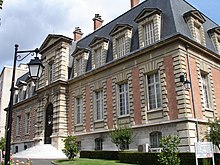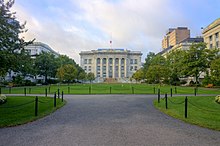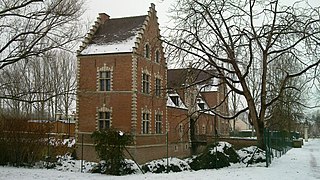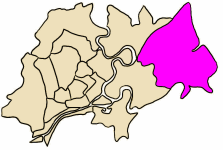
This article is a list of things named after the French scientist Louis Pasteur (1822-1895).

This article is a list of things named after the French scientist Louis Pasteur (1822-1895).

Louis Pasteur Elementary School in Detroit, Michigan (United States)
Louis Pasteur Elementary School in Chicago, Illinois (United States)

| | This section needs expansion. You can help by adding to it. (July 2016) |

In France, there are about 2,020 streets named after Louis Pasteur [1]
Pasteur Street is an important street in Tehran, Iran in which key government institutions are located. It is highly secured because of the presence of key institutions such as the office of the Iranian President, the center of Iran's Revolutionary Guards Intelligence leadership, the center of the Assembly of Experts, and the Supreme National Security Council. Also Several military schools, the center of the Armed Forces Logistics and Center for Strategic Studies are located in the street
Louis Pasteur (1822–1895) was a French chemist and microbiologist.

Hanoi, officially the Hanoi Capital, is the capital and second-most populous city of Vietnam. It covers an area of 3,359.82 km2 (1,297.2 sq mi), and consists of 12 urban districts, one district-level town and 17 rural districts. It is located within the Red River Delta of Northern Vietnam.

Ho Chi Minh City, also commonly known as Saigon, is the most populous city in Vietnam, with a population of around 9.3 million in 2023. Situated in the Southeast region of Vietnam, the city surrounds the Saigon River and covers about 2,061 km2 (796 sq mi).

The 13th arrondissement of Paris is one of the 20 arrondissements of the capital city of France. In spoken French, the arrondissement is referred to as le treizième.

Pasteur is a station on Line 6 and Line 12 of the Paris Métro in the 15th arrondissement. It is named after the French chemist Louis Pasteur. The platforms for both lines are situated underground, although Line 6 becomes elevated as it approaches northwest end of the station. Nearby are the Pasteur Institute and the Lycée Buffon (school).

Villeneuve-d'Ascq is a commune in the Nord department in northern France. With more than 60,000 inhabitants and 50,000 students, it is one of the main cities of the Métropole Européenne de Lille and the largest in area (27.46 km²) after Lille. It is also one of the main cities of the Hauts-de-France region.

Alexandre Emile Jean Yersin was a Swiss-French physician and bacteriologist. He is remembered as the co-discoverer of the bacillus responsible for the bubonic plague or pest, which was later named in his honour: Yersinia pestis. Another bacteriologist, the Japanese physician Kitasato Shibasaburō, is often credited with independently identifying the bacterium a few days earlier. Yersin also demonstrated for the first time that the same bacillus was present in the rodent as well as in the human disease, thus underlining the possible means of transmission.

Garches is a commune in the western suburbs of Paris, France. It is located 11.9 km (7.4 mi) from the centre of Paris.

Chelles is a commune in the eastern suburbs of Paris, France. It is located in the Seine-et-Marne department in the Île-de-France region 18 km (11 mi) from the center of Paris.

Bry-sur-Marne is a commune in the Val-de-Marne department in the eastern suburbs of Paris, France. It is located 12.6 km (7.8 mi) from the center of Paris.
The Lycée français Alexandre Yersin (LFAY) is a French international school in Long Bien District, Hanoi, Vietnam. The school is under the purview of the Agency for French Education Abroad, which manages all French state schools outside France. LFAY teaches children from the ages of 3 to 18 and adopts the French curriculum including the Baccalauréat. The school is known for its high standards and excellent results in the Baccalauréat, with a 95 to 100% success rate and 75 to 100% mentions. Several former students go to prestigious universities, preparatory classes, grandes écoles or schools of arts and architecture in France and abroad.

University of Medicine and Pharmacy at Ho Chi Minh City is one university of medicine and pharmacy in Vietnam. It offers graduate and postgraduate education in medicine, pharmacy. The university has seven faculties and one hospital:

District 2 is a former urban district of Ho Chi Minh City, Vietnam. As of 2010, the district had a population of 140,621 and a total area of 50 km².

District 1 is the central urban district of Ho Chi Minh City (Saigon), the largest city in Vietnam. With a total area of 7.7211 km2 (2.9811 sq mi) the district has a population of 204,899 people as of 2010. The district is divided into 10 small subsets which are called wards (phường). District 1 contains most of the city's administrative offices, consulates, and large buildings. District 1 is the busiest district in the city with the highest living standards. Đồng Khởi Street and Nguyễn Huệ Boulevard in District 1 are the city's two main commercial centers. Đồng Khởi street is an area in high demand for real estate, hitting a record price of $50,000 per square meter in 2007.

District 9 is a former urban district (quận) of Ho Chi Minh City, the largest city in Vietnam. As of 2010, the district had a population of 263,486, and an area of 114 km².

The Institut Français is a French public industrial and commercial organization (EPIC). Started in 1907 by the Ministry of Foreign Affairs for promoting French, francophone as well as local cultures around the world, in 2011 it replaced the CulturesFrance project as the umbrella for all French cultural outreach projects, with an expanded scope of work and increased resources.
Lycée Français Louis Pasteur de Lagos is a French international school in Victoria Island, Lagos, Nigeria. The school has primaire and secondaire levels.

The French Institute in Nigeria (IFN) is part of the worldwide organisation of Instituts français. The Abuja institute is the only in the country.

Quách Thị Trang Square is the city square in front of the well-known Bến Thành Market in District 1, downtown Ho Chi Minh City, Vietnam.